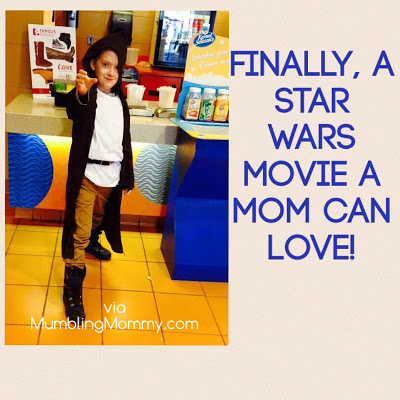I have two sons, and my eldest (age 8) loves all things Star Wars. He’s seen all of the movies, gone through several lightsabers (warning: those “telescoping” ones break easily), had two Star Wars-themed birthday parties, and dressed like a Jedi for the new movie premiere. It’s a great story, and I enjoy it, too. But it is overwhelmingly male-centered, to the point where there are so few women in any given scene that I’ve wondered how they possibly maintain their population in that “galaxy far-far away.”
I realize that since they’re boys, they will often gravitate to stories featuring male protagonists because they find them more relatable, and that’s fine. But as a woman, mother, and teacher, I feel responsible for showing my sons that good stories can feature men OR women or both, working together.
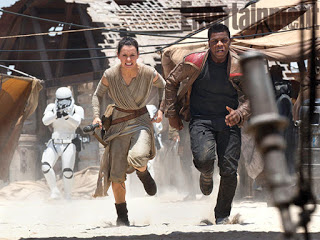 |
| Copyright: Lucasfilm 2015. |
Which takes us to Star Wars and Feminism.
In the original trilogy, Princess Leia is plucky and courageous, but she’s not much else. She has precious little backstory, beyond being adopted into royalty, and her character’s development relies entirely on her relationships with men: her brother, her father, and her lover.
Padme Amidala is, oddly, a step backwards for women in Star Wars, even though the second trilogy was filmed much later. Lacking most of Leia’s pluck, she spends her time as a pawn/ agent/ lover/ victim of the various men in her life. She has very little agency and literally dies of sadness.
There are various side characters and a few more female characters in the animated spin-offs, but still, in the balance, the most interesting, complex, significant roles have been played by men. In its first six movies, Star Wars reinforced the old stereotype that “boys have adventures; girls have relationships.”
Until Rey.
(Warning: minor spoilers ahead!)
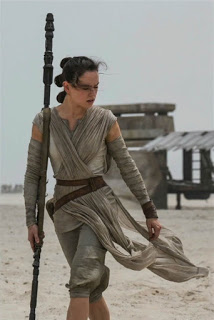 |
| Rey. Copyright: Lucasfilm 2015. |
Whether or not you’ve seen the movie yet, you’ve probably heard about Rey (yes, that’s her whole name … so far), the young scavenger who gets sucked into the story when she meets Finn, the stormtrooper-turned-resistance fighter. You’ve at least seen her picture, with her no-nonsense clothes and hair, fighting or running for her life.
What you might not realize is that a.) she’s the main character (not Finn), and b.) she’s the best female character to ever grace a Star Wars movie and one of the few female action stars who isn’t hyper-sexualized.
(Interestingly, she was left out of several toy sets, and her Lego mini-figure, with her lipstick and mascara, looks more traditionally “feminine” than Rey did in the film. Perhaps J.J. Abrams needs to have a chat with toy manufacturers about how to market this character.)
Rey is not a two-dimensional action hero either. She has a compelling backstory and nuanced relationships with characters that go beyond fight scenes. Actress Daisy Ridley does an excellent job of balancing Rey’s necessary toughness with emotional vulnerability.
When we first meet Rey, she is living alone as a scavenger on a desert planet. She is not a princess or a queen, but an ordinary girl forced to live by her wits and physical strength in a harsh environment. We see her work, struggle to earn enough to eat, and deal with loneliness and isolation. Her clothes and hair are functional, not “sexy,” and although she is waiting for someone, she does not need to be “rescued.”
Finn comes onto the scene, and at first, he thinks she needs rescuing, which creates a wonderfully satirical “meet cute” scene. Thugs are harassing Rey, trying to steal BB-8, the adorable rolling droid. Finn notices and charges in, ready to ride to the fair maiden’s rescue, only to arrive just after she’s knocked the thugs out with her large staff. When she notices Finn watching, she chases him down, too.
This pattern repeats throughout the movie, with Finn trying to be chivalric, only to be thwarted by Rey’s strength and intelligence. This marks a radical change from Leia, who needed saving before she was even properly onscreen, and Amidala, whose love interest also served as her bodyguard.
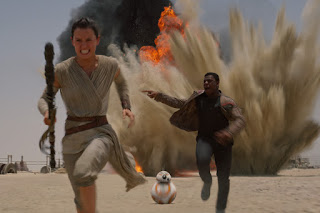 |
| Yes, there’s a lot of running, and no, she’s not paying attention to whatever Finn is trying to say here. Copyright: Lucasfilm 2015. |
Most importantly, Rey’s character development is not dependent on her relationship with men. Instead, her most pivotal moments stem from her relationship with the Force itself.
In previous movies, the Force, which is supposed to be a gender-less, all-encompassing life-force, is primarily operated by men. But here we see a young woman with a deep Force-sensitivity that trumps everyone else in the film, even the main antagonist.
This power is awakened not by a male mentor but by an older woman, Maz Kanata (played by Lupita Nyong’o.) Their conversation marks the first time a Star Wars film legitimately passes the Bechdel test, which asks the questions 1.) are there two women in the movie and 2.) do they talk about anything other than a man?
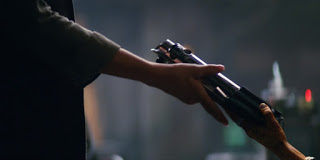 |
| A woman handing another woman a lightsaber? Shocking! Copyright: Lucasfilm 2015. |
I could say more, but then I’d be giving away major spoilers. Let’s just say that Rey proves herself and leaves plenty of room for future character development. I can’t wait to see where her story, and Star Wars and Feminism, goes from here.
First time here? Like Mumbling Mommy on Facebook to continue the conversation!
While you’re here, you may enjoy these other posts:
Beyond Princesses: The Case for Studio Ghibli
The Problem with Princesses: Raising Daughters Amid All the Pink
Gender Equality: We’ve Made it So Far … But Not Far Enough
Category: Family Free TimeTags: Elizabeth








